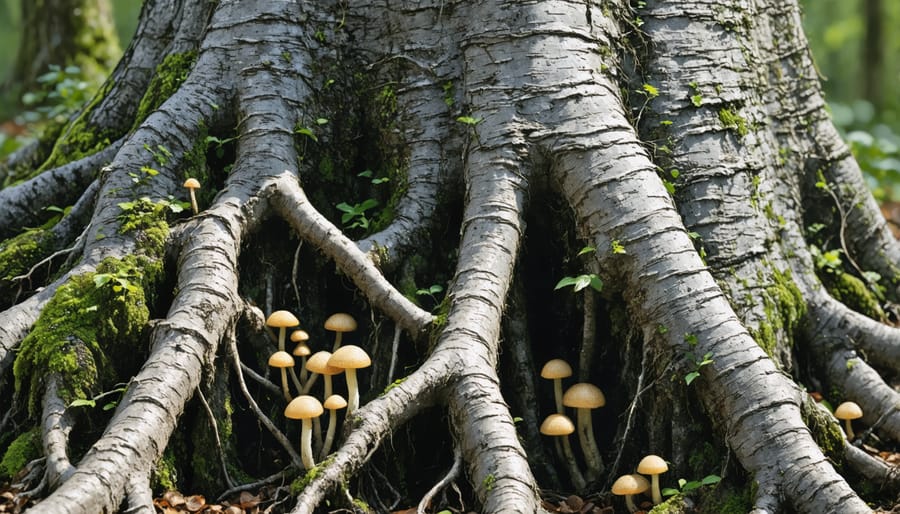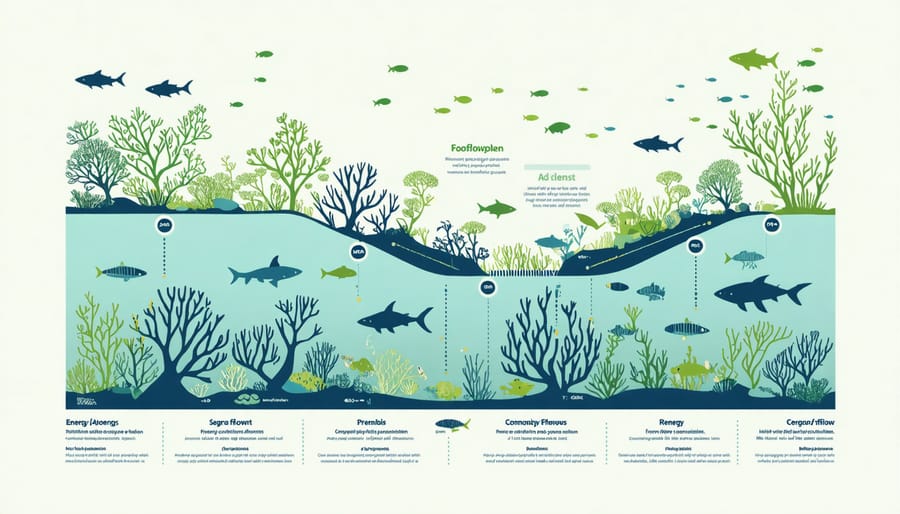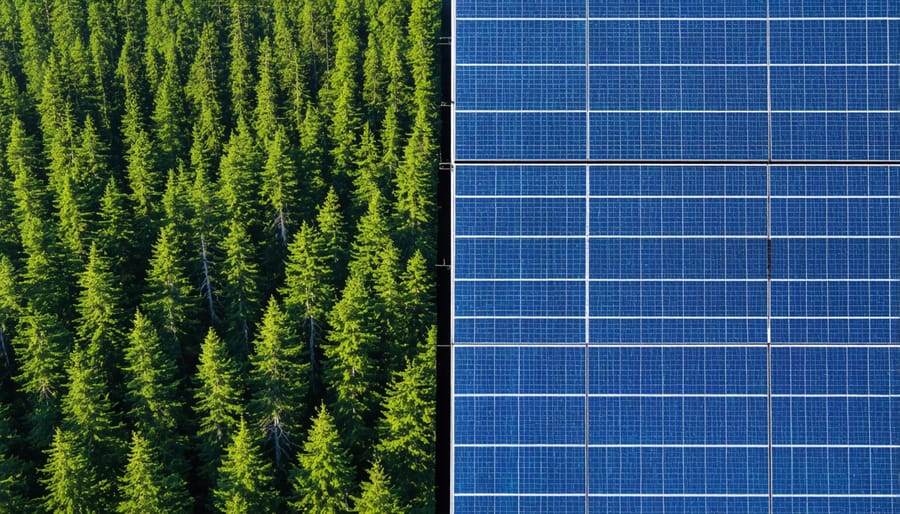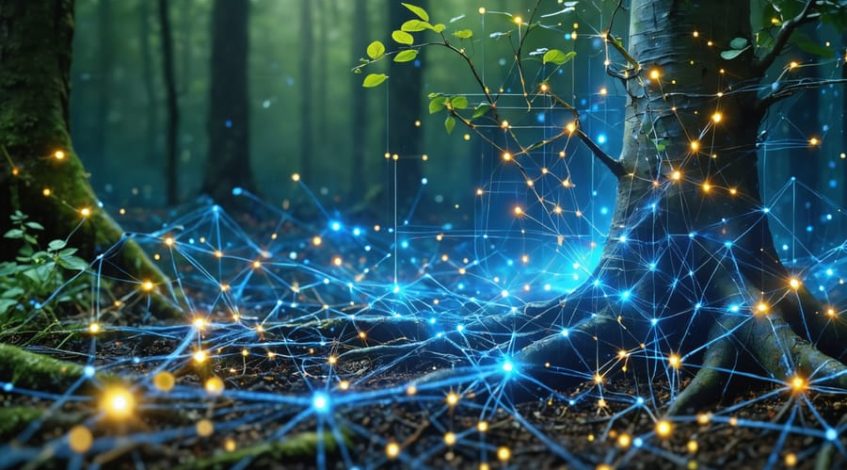Nature’s most remarkable innovations emerge through the power of synergistic relationships, where distinct elements combine to create outcomes far greater than the sum of their parts. From the intricate dance between flowering plants and their pollinators to the sophisticated smart energy integration observed in coral reef ecosystems, these natural partnerships offer invaluable insights for modern energy solutions.
The study of biological synergies has revolutionized our approach to sustainable technology development, particularly in renewable energy systems. Consider how mycorrhizal fungi networks enhance forest resilience through resource sharing, or how prairie ecosystems maximize solar energy capture through complementary plant heights and growth patterns. These natural examples demonstrate perfect efficiency without waste—a model that forward-thinking businesses increasingly emulate in their energy management strategies.
By understanding and applying these biological principles to commercial energy systems, organizations can achieve unprecedented levels of operational efficiency and sustainability. The key lies in recognizing that, like nature’s most successful systems, optimal energy solutions emerge from carefully orchestrated interactions between multiple components, each supporting and enhancing the others’ performance.
Biological Energy Networks: Nature’s Smart Grid Blueprint
Forest Mycorrhizal Networks
Forest mycorrhizal networks represent one of nature’s most sophisticated examples of resource sharing and mutual benefit. These complex underground systems, formed by fungi connecting multiple trees, facilitate the transfer of water, carbon, nitrogen, and other essential nutrients throughout forest communities. Much like modern smart grids, these networks enable efficient resource distribution based on need and availability.
Research has shown that larger, older trees often act as hub nodes, supporting younger saplings through nutrient transfer via these fungal connections. This natural system demonstrates remarkable efficiency, with resources flowing from areas of abundance to areas of scarcity, ensuring optimal resource utilization across the entire forest ecosystem.
The network’s ability to detect and respond to environmental stresses parallels advanced monitoring systems in modern infrastructure. When one tree experiences drought or disease, the network can redirect resources to support the stressed individual, maintaining overall system resilience. This natural model of decentralized resource sharing and adaptive response provides valuable insights for designing more efficient and resilient human-engineered systems, particularly in the context of energy distribution and resource management.

Coral Reef Energy Exchange
Coral reef ecosystems exemplify one of nature’s most sophisticated examples of synergistic energy exchange, offering valuable insights for modern energy system design. The relationship between coral polyps and zooxanthellae algae demonstrates a remarkably efficient closed-loop energy system. The algae, living within coral tissues, capture sunlight and convert it into chemical energy through photosynthesis, providing up to 90% of the coral’s energy requirements. In return, corals supply the algae with essential nutrients and a protected environment.
This symbiotic partnership extends beyond the immediate participants. The reef structure itself creates habitat niches that support numerous other energy exchange relationships. Fish species clean parasites from larger marine animals, receiving nutrition while providing a vital service. Meanwhile, the physical reef formation influences water flow patterns, creating nutrient-rich microcurrents that benefit the entire ecosystem.
Understanding these natural energy exchange mechanisms has inspired innovations in distributed energy systems and smart grid technologies, particularly in developing more efficient methods of energy storage and distribution across interconnected networks.

Smart Grid Innovations Inspired by Natural Systems
Distributed Energy Resources
Nature’s ecosystems demonstrate remarkable efficiency through decentralized resource distribution, a pattern that modern distributed energy systems increasingly emulate. Just as forests maintain resilience through diverse energy capture and storage mechanisms, today’s smart grids integrate multiple power sources across various locations, creating robust and adaptive energy networks.
This natural synergy is evident in how plants in a forest canopy optimize sunlight capture through different height levels and leaf orientations. Similarly, modern microgrids combine rooftop solar arrays, energy storage systems, and smart controllers to maximize power generation and distribution efficiency. The result is a more resilient and sustainable energy infrastructure that can better withstand disruptions and adapt to changing demands.
The parallel extends to energy sharing mechanisms. Like mycorrhizal networks in forests that distribute nutrients among trees, smart grid technologies enable bi-directional power flow, allowing excess energy to be shared across the network when needed. This decentralized approach not only improves system reliability but also reduces transmission losses and infrastructure costs, much like nature’s own efficient resource allocation systems.
By adopting these biomimetic principles, organizations can create more sustainable and cost-effective energy solutions that mirror the time-tested strategies of natural ecosystems.
Adaptive Load Balancing
Nature demonstrates remarkable efficiency in distributing resources through adaptive load balancing, a principle that modern smart grid systems increasingly emulate. Consider how bee colonies dynamically adjust their foraging patterns based on available flower resources and colony needs, or how ant colonies optimize their food collection routes through pheromone-based communication.
These natural systems showcase three key principles that inform modern grid management: real-time response to changing conditions, decentralized decision-making, and efficient resource allocation. For instance, when a beehive discovers a rich nectar source, it quickly redirects workers while maintaining essential hive operations – a pattern that parallels how smart grids must balance peak demand periods with baseline power requirements.
Energy systems now incorporate these biological principles through advanced monitoring systems and automated load distribution protocols. Like a forest ecosystem that redistributes nutrients through mycorrhizal networks, smart grids can dynamically shift power resources across regions based on demand fluctuations. This natural-inspired approach has proven particularly effective in managing renewable energy integration, where supply variability requires adaptive response mechanisms.
The implementation of these bio-inspired strategies has led to significant improvements in grid stability and efficiency. Organizations reporting up to 30% reduction in peak load management costs through adaptive balancing systems, demonstrating how natural synergies can translate into tangible business benefits.
Energy Storage Solutions
Nature’s ingenious energy storage mechanisms offer valuable insights for modern sustainable technology development. Plants, for instance, demonstrate remarkable efficiency in storing solar energy through photosynthesis, converting light into chemical energy stored in glucose molecules. This natural process has inspired the development of artificial photosynthesis systems and advanced battery technologies.
The desert succulent’s ability to store water and energy for extended periods has influenced the design of thermal energy storage systems. These plants maintain optimal function during drought conditions through specialized tissue structures, a principle now applied in phase-change materials used in building climate control systems.
Animal hibernation provides another compelling example of efficient energy management. Bears can reduce their metabolic rate while maintaining essential functions during winter months, utilizing stored fat reserves with remarkable efficiency. This biological process has inspired research into grid-scale energy storage solutions that can effectively manage supply and demand fluctuations.
Marine organisms like electric eels generate and store electrical charge through specialized cell structures called electrocytes. Scientists have adapted this concept to develop bio-inspired batteries and capacitors with improved energy density and discharge capabilities. These innovations are particularly relevant for renewable energy storage applications.
The collective behavior of honeybee colonies in managing hive temperature has influenced smart grid development, demonstrating how distributed energy storage and consumption can be optimized across networks. This natural model of energy distribution continues to inspire improvements in grid-scale storage solutions and demand response systems.
Implementation in Modern Energy Ecosystems
Commercial Solar Integration
Nature’s synergistic principles have revolutionized commercial solar installations, leading to more efficient and sustainable energy solutions. Taking inspiration from the spiral patterns found in sunflowers, modern solar farms now implement biomimetic layouts that maximize energy capture while minimizing space requirements. This arrangement, known as phyllotaxis, has demonstrated up to 32% better land use efficiency compared to traditional grid layouts.
The self-cleaning properties of lotus leaves have inspired the development of hydrophobic coatings for solar panels, reducing maintenance costs and improving overall system efficiency. These specialized surfaces repel dust and debris, maintaining optimal energy production without frequent manual cleaning interventions.
Energy storage systems in commercial solar installations now mimic the efficient energy management found in plant cells. Similar to how plants store energy during photosynthesis, advanced battery systems integrated with solar arrays ensure consistent power delivery even during non-peak production hours.
Adaptive tracking systems inspired by heliotropic plants, which naturally follow the sun’s movement, have enhanced energy capture in large-scale installations. These systems can increase energy yield by up to 25% compared to fixed installations, providing better return on investment for commercial properties.
The collective behavior of social insects has influenced the development of smart grid management systems, enabling better load distribution and maintenance scheduling across large solar arrays, ultimately improving system reliability and performance.

Community-Based Energy Networks
Nature’s distributed energy networks, such as those found in fungal networks beneath forest floors, provide inspiring models for modern community energy systems. These natural systems demonstrate how resources can be efficiently shared and distributed across interconnected networks, maximizing benefit for all participants while minimizing waste.
Today’s community solar initiatives mirror this natural synergy by creating microgrids that enable local energy sharing. Just as trees share nutrients through mycorrhizal networks, these energy systems allow excess power generated by one building to support neighboring structures during peak demand periods.
The parallels between natural resource distribution and smart grid technology are particularly evident in demand response systems. Like how plant communities regulate resource allocation based on environmental conditions, modern energy networks can dynamically adjust power distribution based on real-time usage patterns and availability.
This biomimetic approach to energy management has proven particularly effective in commercial districts, where diverse energy consumption patterns create natural opportunities for load balancing. By implementing these nature-inspired distribution models, communities can achieve greater energy resilience while reducing infrastructure costs and environmental impact.
These systems demonstrate how understanding and applying natural synergies can lead to more efficient and sustainable energy solutions, particularly in urban environments where resource optimization is crucial.
Nature’s time-tested synergistic relationships offer invaluable insights for the future of smart grid development. By studying and adapting these natural patterns, engineers and energy professionals are creating more resilient and efficient power distribution systems. The emergence of local energy sharing networks demonstrates how biomimicry principles can transform our energy infrastructure.
Looking ahead, the integration of nature-inspired technologies in smart grids promises unprecedented advances in energy management. Adaptive load balancing inspired by ant colonies, self-healing networks modeled after plant systems, and dynamic energy storage solutions based on animal hibernation patterns are just the beginning. These innovations are particularly relevant for commercial and industrial applications, where energy demands are complex and variable.
The future of smart grid development lies in combining these natural principles with cutting-edge technology. Machine learning algorithms that mimic natural selection processes will optimize energy distribution, while decentralized networks inspired by mycorrhizal networks will enhance grid resilience. As we continue to face growing energy challenges, these nature-inspired solutions offer a sustainable pathway forward, promising reduced costs, improved efficiency, and enhanced grid stability for businesses and communities alike.

